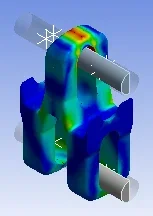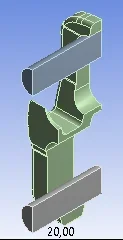verdell1
Guest
Hello everyone,
I realized a fem simulation with ansys wb on an element that has two symmetrical planes but is not symmetrical around the orthogonal plane to the traction axis: to realize it I added two pins, the lower one that acts as a bond and the upper one that transmits the load to which I imposed a shift along the traction axis. the force exerted I read it from the binding reaction towards the traction axis of the lower pin.
Now, my question is rather trivial but I need certainties: the force that I read, having used in the analysis only a quarter of geometry thanks to the symmetries, I have to multiply it for 4 to get that "really" exercised, right?
attach photos of complete geometry and cut for better understanding.

 thanks to all
thanks to all
I realized a fem simulation with ansys wb on an element that has two symmetrical planes but is not symmetrical around the orthogonal plane to the traction axis: to realize it I added two pins, the lower one that acts as a bond and the upper one that transmits the load to which I imposed a shift along the traction axis. the force exerted I read it from the binding reaction towards the traction axis of the lower pin.
Now, my question is rather trivial but I need certainties: the force that I read, having used in the analysis only a quarter of geometry thanks to the symmetries, I have to multiply it for 4 to get that "really" exercised, right?
attach photos of complete geometry and cut for better understanding.

 thanks to all
thanks to all